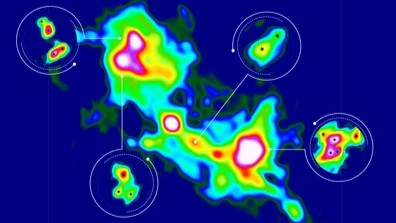Huge stars are born as twins, triplets and more, new images confirm
'Finally, we were able to take a detailed look at the rich array of multiple star systems in a massive star formation region!'

A newly imaged crowded star cluster is birthing groups of three, four and five stars, confirming the prevailing wisdom that the universe forms its stars in multiples, astronomers reported last week.
Observations made with the Atacama Large Millimetre-submillimetre Array (ALMA) in Chile gathered between 2016 and 2019 of 30 large star-forming regions show that one protocluster, named G333.23-0.06, is birthing groups of multiple stars: four binaries, a triplet, a quadruple and one quintuple system. The findings, reported Jan. 15 in the journal Nature Astronomy, are consistent with what star formation models have long predicted, astronomers say.
"Finally, we were able to take a detailed look at the rich array of multiple star systems in a massive star formation region!" study co-author Henrik Beuther, of the Max Planck Institute for Astronomy (MPIA) in Germany, said in a statement.
"Particularly exciting is that the observations go as far as to provide evidence for a specific scenario for high-mass star formation," Beuther said.
Related: Meet ALMA: Amazing photos from the giant radio telescope array
Although models have long suggested multiple star births to be the norm, observational evidence has been hard to get, thanks to the dust-rich nature of stellar nurseries, which make imaging them difficult. Prior to the new ALMA results, observations had shown isolated multiple star systems within clusters, "but nothing like the teeming crowd of multiples predicted by the simulations," according to the MPIA statement.
To image the newfound stellar cluster, which spans 0.62 by 0.78 light-years in size, ALMA effectively used 66 radio antennas as one humongous radio telescope, allowing astronomers to peer through the largely opaque dusty clouds.
Breaking space news, the latest updates on rocket launches, skywatching events and more!
Although the early results on G333.23-0.06 don’t say much about the behavior of its stellar residents, the orbits and evolution of stars packed in such crowded environments are known to be gravitationally influenced by their celestial neighbors. Multiple-star systems are also known to support planets, even in their potentially life-friendly habitable zones.
The ALMA images also reveal that the young stars in G333.23-0.06 don't have disks of dust and gas around them, indicating that they are forming via a different, hierarchical process known to astronomers as "core fragmentation," according to the new study. Simulations of star formation show that large gas clouds first contract into dense cores, within which smaller regions collapse into groups of stars. The simulations show that a small percentage of stars become many times more massive than our sun, which formed in a similar cluster.
"Our observations seem to indicate that when the cloud collapses, the multiples form very early on," said lead author Shanghuo Li, also of MPIA. "But is that really the case?"
Forthcoming analyses of roughly 50 other star clusters, "some of them younger than G333.23–0.06, should give us the answer."

Sharmila Kuthunur is an independent space journalist based in Bengaluru, India. Her work has also appeared in Scientific American, Science, Astronomy and Live Science, among other publications. She holds a master's degree in journalism from Northeastern University in Boston.
